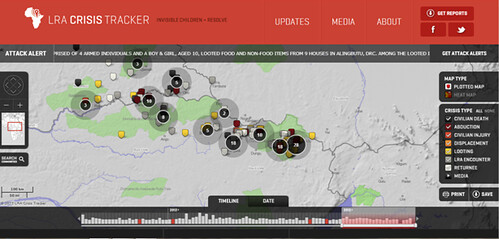On the Radar: Using Data to Save Lives
Saskia Rotshuizen - June 17, 2013 in Data for CSOs
The field of crisis mapping is relatively new, but its impact on the global response to conflict is already evident. By enabling massive amounts of information to be quickly understood by any interested party, crisis mapping increases public awareness on a exponential scale and, if properly put together, allows for quicker responses to crises.
Invisible Children together with the Resolve LRA Crisis Initiative ventured into this field in 2011 with the launch of the LRA Crisis Tracker. This platform was created as a response to the lack of response to the Makombo Massacres in DR Congo where more than 320 people were killed and 250 people abducted by the Lord’s Resistance Army (LRA). Three months passed before news of the massacres appeared in the media.
Inspired by Ushahidi, the free, build-your-own crisis map website, the LRA Crisis Tracker is a real-time mapping platform and data collection system that brings an unprecedented level of transparency to the atrocities committed by the LRA in central Africa.
To build our own platform we partnered with Digitaria, a San Diego-based digital agency, and used a custom-built SalesForce application on the back end. Building the LRA Crisis Tracker was an extensive process. Each of the partners dedicated a few members of their team to work on the project full time. After nine months of development the LRA Crisis Tracker was launched in September 2011.
The Crisis Tracker faces the unique challenge of getting reliable reports from a region that has little to no communication infrastructure. The solution to this problem, in large part, was found in Invisible Children’s expansion of a locally-run high frequency (HF) radio network throughout communities in DR Congo and the Central African Republic. Twice daily, radio reports go to a local hub that then sends this information to our office in San Diego. Obtaining reliable data in a timely manner from such a remote region has required a serious investment of time and money. We’ve been building this network for almost two years and it provides much of the data used by the LRA Crisis Tracker. Invisible Children’s HF radio network currently consists of 38 radios and will continue to grow.
Through its intuitive design and inclusion of photos and videos from the region, the data is engaging and easy to access. The LRA Crisis Tracker is also available as a mobile app (iPhone or Android), and @CrisisTracker tweets LRA incidents as they’re reported.
Reports generated by the LRA Crisis Tracker have been used at all levels of counter-LRA efforts. Military and non-military actors in the region have expressed their appreciation of the real-time information put out by the LRA Crisis Tracker. This is exactly what we were hoping to create: an easy-to-access resource for the media, counter-LRA actors, regional organizations, and the general public. It makes it possible to identify trends in LRA activity that wouldn’t otherwise be accessible.
The platform continues to be a work in progress. Since its creation we’ve had to go back and revisit the data set multiple times. At one point we went back and added age and gender to incident reports. Other times we are mining our data for new location specifications. Our team spends a lot of time vetting our data to make sure it is accurate, which really is the most crucial aspect of our work.
This summer we’re planning to roll out Phase II of the LRA Crisis Tracker, which will improve the user’s ability to filter and analyze data. We’re excited to make the LRA Crisis Tracker even more valuable in the efforts to bring a permanent end to LRA atrocities. Already the platform makes our data available to any interested data-enthusiasts, through the ‘Get Reports’ Tab.


